[SOLVED] Jan's Situation and Leadership Challenges
VerifiedAdded on 2021/04/24
|13
|4265
|25
AI Summary
This assignment requires a thorough examination of Jan's situation as he takes over at SewDigi. The document must be published on Desklib, which provides best past papers and solved assignments for students. It is essential to highlight Jan's expertise and experience in building great companies, even during recessions. However, it is crucial not to put him under pressure and allow him time to settle without lenses of management at all times.
Contribute Materials
Your contribution can guide someone’s learning journey. Share your
documents today.
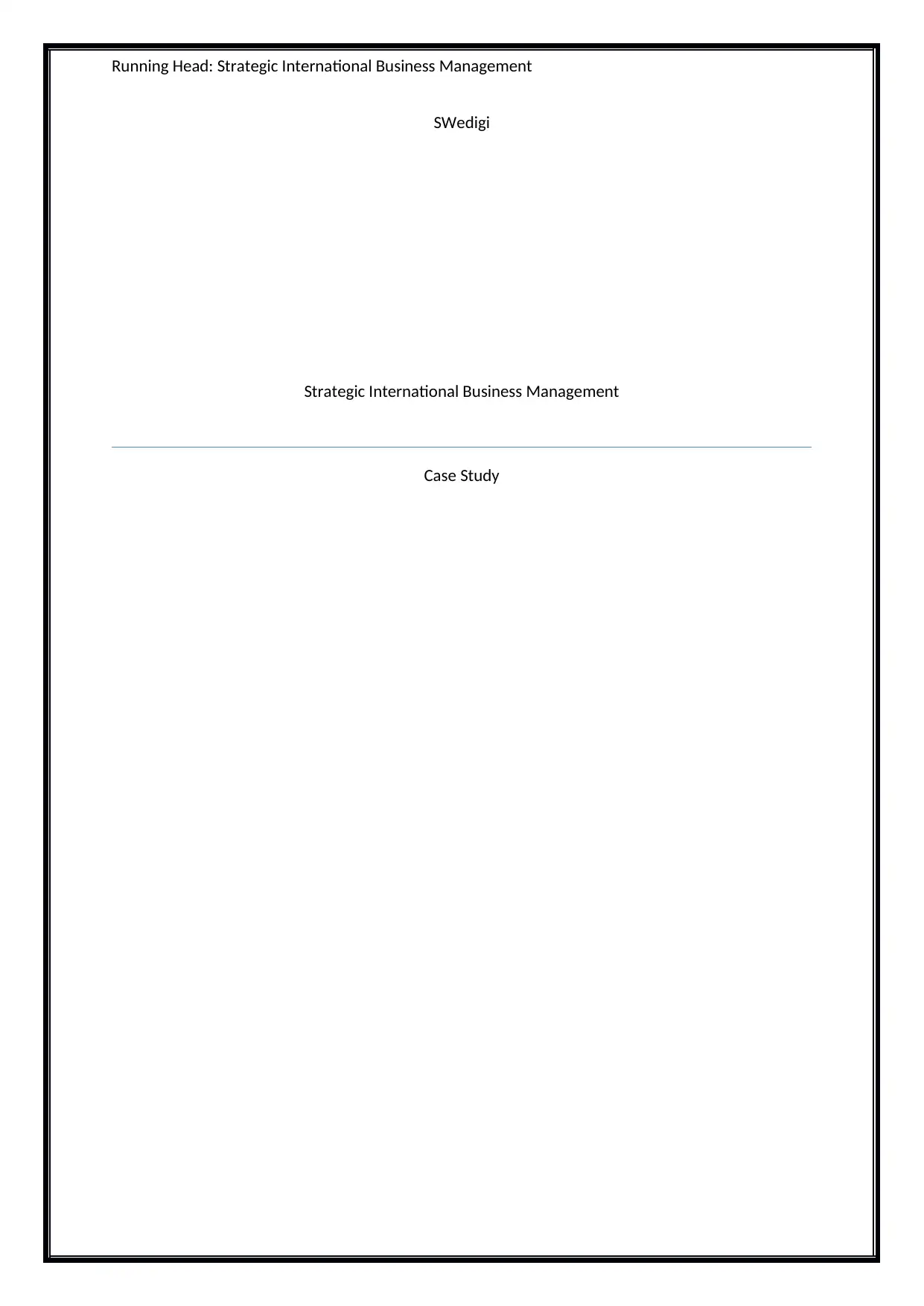
Running Head: Strategic International Business Management
SWedigi
Strategic International Business Management
Case Study
SWedigi
Strategic International Business Management
Case Study
Secure Best Marks with AI Grader
Need help grading? Try our AI Grader for instant feedback on your assignments.
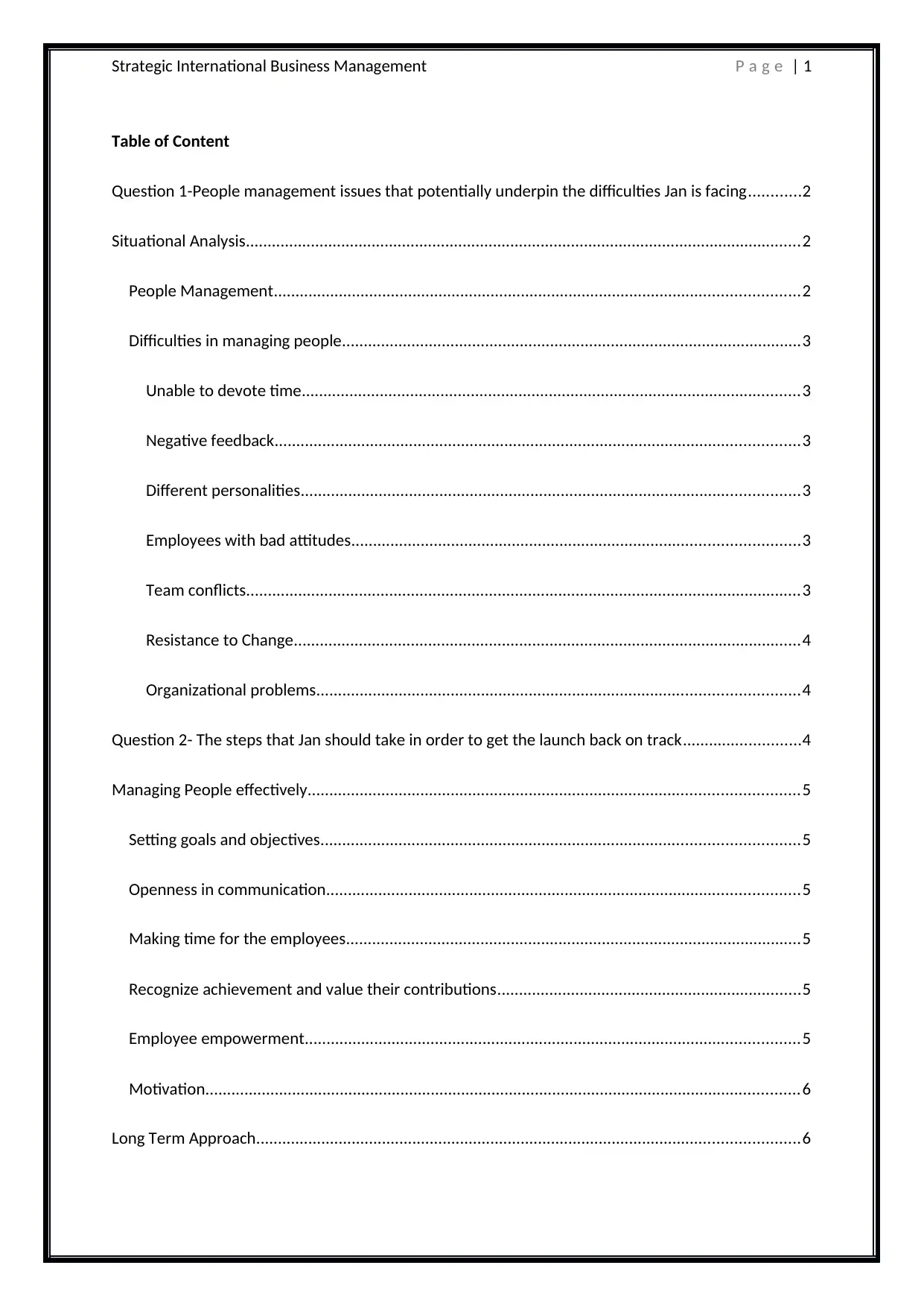
Strategic International Business Management P a g e | 1
Table of Content
Question 1-People management issues that potentially underpin the difficulties Jan is facing............2
Situational Analysis................................................................................................................................2
People Management.........................................................................................................................2
Difficulties in managing people..........................................................................................................3
Unable to devote time...................................................................................................................3
Negative feedback.........................................................................................................................3
Different personalities...................................................................................................................3
Employees with bad attitudes.......................................................................................................3
Team conflicts................................................................................................................................3
Resistance to Change.....................................................................................................................4
Organizational problems...............................................................................................................4
Question 2- The steps that Jan should take in order to get the launch back on track...........................4
Managing People effectively.................................................................................................................5
Setting goals and objectives..............................................................................................................5
Openness in communication.............................................................................................................5
Making time for the employees.........................................................................................................5
Recognize achievement and value their contributions......................................................................5
Employee empowerment..................................................................................................................5
Motivation.........................................................................................................................................6
Long Term Approach.............................................................................................................................6
Table of Content
Question 1-People management issues that potentially underpin the difficulties Jan is facing............2
Situational Analysis................................................................................................................................2
People Management.........................................................................................................................2
Difficulties in managing people..........................................................................................................3
Unable to devote time...................................................................................................................3
Negative feedback.........................................................................................................................3
Different personalities...................................................................................................................3
Employees with bad attitudes.......................................................................................................3
Team conflicts................................................................................................................................3
Resistance to Change.....................................................................................................................4
Organizational problems...............................................................................................................4
Question 2- The steps that Jan should take in order to get the launch back on track...........................4
Managing People effectively.................................................................................................................5
Setting goals and objectives..............................................................................................................5
Openness in communication.............................................................................................................5
Making time for the employees.........................................................................................................5
Recognize achievement and value their contributions......................................................................5
Employee empowerment..................................................................................................................5
Motivation.........................................................................................................................................6
Long Term Approach.............................................................................................................................6

Strategic International Business Management P a g e | 2
Change Management............................................................................................................................6
Lewin’s change management Model.................................................................................................7
Implement the change...................................................................................................................7
Refreeze the new change..............................................................................................................8
Question 3: Leadership style Jan should implement in the process and the reasons for the style........8
Question 4:Support needed from the management to improve the present situation.......................10
References...........................................................................................................................................10
Question 1-People management issues that potentially underpin the
difficulties Jan is facing
Situational Analysis
Jan had been recently appointed as the CEO of SweDigi, a Swedish company which operates as a
sub-contractor to the digital music Industry. Jan had a glorious past and tasted success in the initial
years of his professional journey, thus was given the responsibility of improving the financial health
of the company. Jan proactively thought of launching a new product in the media industry, to regain
the lost market share; however things did not seem to work in his favour. The resignation of
marketing manager, high turnover in the company, increasing threats by production manager to
leave the company and the decreasing sales are some of the major challenges being faced by Jan.
The team at SweDigi has accused Jan of not working with the team and taking own decisions without
involving the team.
People Management
Jan in his early 40s tasted success by selling of his earlier venture at a good profit margin, the
exceptional skills displayed by Jan at such an early age is the reason why the management decided
to bring him on board as the CEO. It was further noticed that the strategy of Jan which involves
launching a new product in the media industry is not taking a dream run. People don’t trust Jan; do
Change Management............................................................................................................................6
Lewin’s change management Model.................................................................................................7
Implement the change...................................................................................................................7
Refreeze the new change..............................................................................................................8
Question 3: Leadership style Jan should implement in the process and the reasons for the style........8
Question 4:Support needed from the management to improve the present situation.......................10
References...........................................................................................................................................10
Question 1-People management issues that potentially underpin the
difficulties Jan is facing
Situational Analysis
Jan had been recently appointed as the CEO of SweDigi, a Swedish company which operates as a
sub-contractor to the digital music Industry. Jan had a glorious past and tasted success in the initial
years of his professional journey, thus was given the responsibility of improving the financial health
of the company. Jan proactively thought of launching a new product in the media industry, to regain
the lost market share; however things did not seem to work in his favour. The resignation of
marketing manager, high turnover in the company, increasing threats by production manager to
leave the company and the decreasing sales are some of the major challenges being faced by Jan.
The team at SweDigi has accused Jan of not working with the team and taking own decisions without
involving the team.
People Management
Jan in his early 40s tasted success by selling of his earlier venture at a good profit margin, the
exceptional skills displayed by Jan at such an early age is the reason why the management decided
to bring him on board as the CEO. It was further noticed that the strategy of Jan which involves
launching a new product in the media industry is not taking a dream run. People don’t trust Jan; do
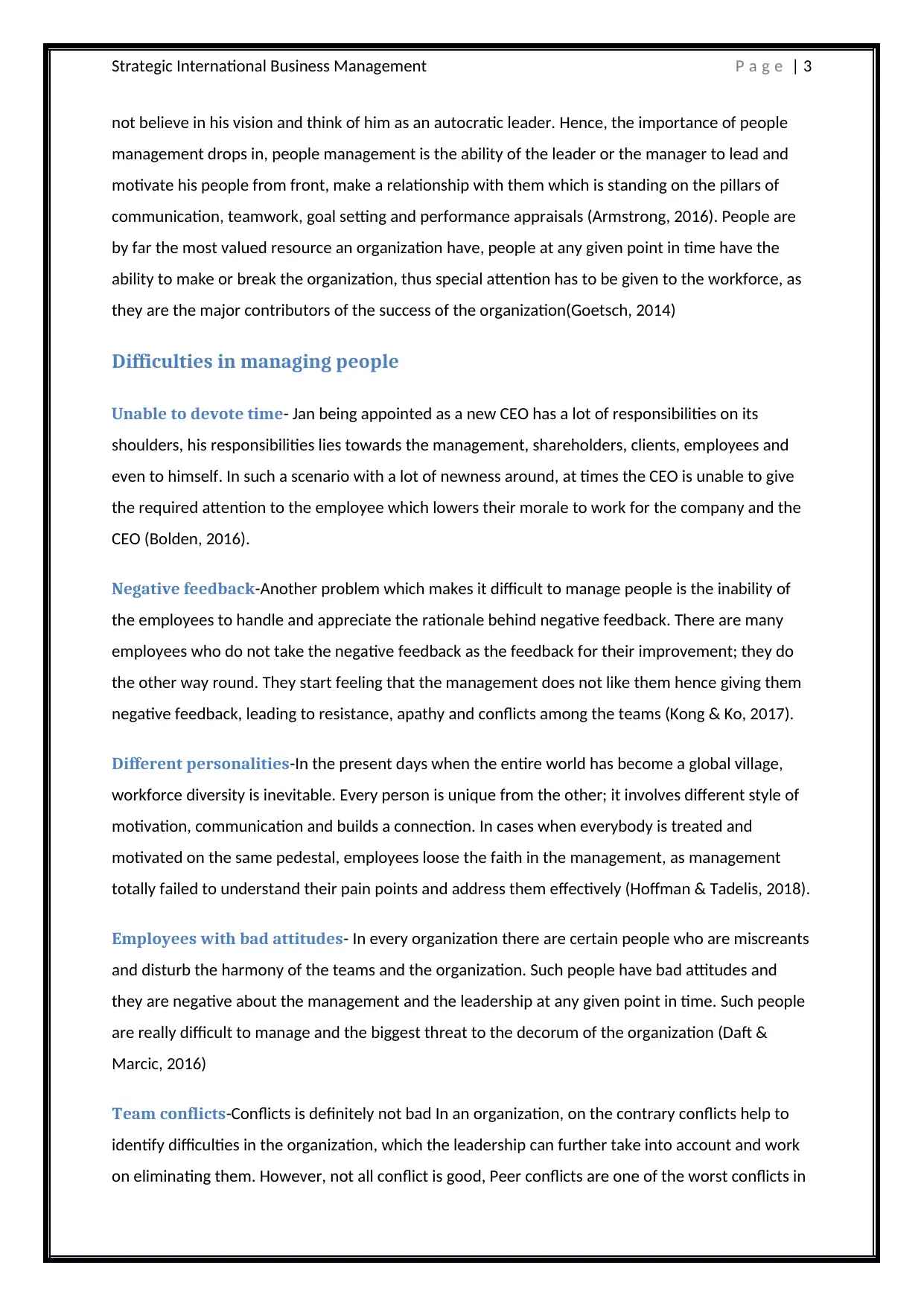
Strategic International Business Management P a g e | 3
not believe in his vision and think of him as an autocratic leader. Hence, the importance of people
management drops in, people management is the ability of the leader or the manager to lead and
motivate his people from front, make a relationship with them which is standing on the pillars of
communication, teamwork, goal setting and performance appraisals (Armstrong, 2016). People are
by far the most valued resource an organization have, people at any given point in time have the
ability to make or break the organization, thus special attention has to be given to the workforce, as
they are the major contributors of the success of the organization(Goetsch, 2014)
Difficulties in managing people
Unable to devote time- Jan being appointed as a new CEO has a lot of responsibilities on its
shoulders, his responsibilities lies towards the management, shareholders, clients, employees and
even to himself. In such a scenario with a lot of newness around, at times the CEO is unable to give
the required attention to the employee which lowers their morale to work for the company and the
CEO (Bolden, 2016).
Negative feedback-Another problem which makes it difficult to manage people is the inability of
the employees to handle and appreciate the rationale behind negative feedback. There are many
employees who do not take the negative feedback as the feedback for their improvement; they do
the other way round. They start feeling that the management does not like them hence giving them
negative feedback, leading to resistance, apathy and conflicts among the teams (Kong & Ko, 2017).
Different personalities-In the present days when the entire world has become a global village,
workforce diversity is inevitable. Every person is unique from the other; it involves different style of
motivation, communication and builds a connection. In cases when everybody is treated and
motivated on the same pedestal, employees loose the faith in the management, as management
totally failed to understand their pain points and address them effectively (Hoffman & Tadelis, 2018).
Employees with bad attitudes- In every organization there are certain people who are miscreants
and disturb the harmony of the teams and the organization. Such people have bad attitudes and
they are negative about the management and the leadership at any given point in time. Such people
are really difficult to manage and the biggest threat to the decorum of the organization (Daft &
Marcic, 2016)
Team conflicts-Conflicts is definitely not bad In an organization, on the contrary conflicts help to
identify difficulties in the organization, which the leadership can further take into account and work
on eliminating them. However, not all conflict is good, Peer conflicts are one of the worst conflicts in
not believe in his vision and think of him as an autocratic leader. Hence, the importance of people
management drops in, people management is the ability of the leader or the manager to lead and
motivate his people from front, make a relationship with them which is standing on the pillars of
communication, teamwork, goal setting and performance appraisals (Armstrong, 2016). People are
by far the most valued resource an organization have, people at any given point in time have the
ability to make or break the organization, thus special attention has to be given to the workforce, as
they are the major contributors of the success of the organization(Goetsch, 2014)
Difficulties in managing people
Unable to devote time- Jan being appointed as a new CEO has a lot of responsibilities on its
shoulders, his responsibilities lies towards the management, shareholders, clients, employees and
even to himself. In such a scenario with a lot of newness around, at times the CEO is unable to give
the required attention to the employee which lowers their morale to work for the company and the
CEO (Bolden, 2016).
Negative feedback-Another problem which makes it difficult to manage people is the inability of
the employees to handle and appreciate the rationale behind negative feedback. There are many
employees who do not take the negative feedback as the feedback for their improvement; they do
the other way round. They start feeling that the management does not like them hence giving them
negative feedback, leading to resistance, apathy and conflicts among the teams (Kong & Ko, 2017).
Different personalities-In the present days when the entire world has become a global village,
workforce diversity is inevitable. Every person is unique from the other; it involves different style of
motivation, communication and builds a connection. In cases when everybody is treated and
motivated on the same pedestal, employees loose the faith in the management, as management
totally failed to understand their pain points and address them effectively (Hoffman & Tadelis, 2018).
Employees with bad attitudes- In every organization there are certain people who are miscreants
and disturb the harmony of the teams and the organization. Such people have bad attitudes and
they are negative about the management and the leadership at any given point in time. Such people
are really difficult to manage and the biggest threat to the decorum of the organization (Daft &
Marcic, 2016)
Team conflicts-Conflicts is definitely not bad In an organization, on the contrary conflicts help to
identify difficulties in the organization, which the leadership can further take into account and work
on eliminating them. However, not all conflict is good, Peer conflicts are one of the worst conflicts in
Secure Best Marks with AI Grader
Need help grading? Try our AI Grader for instant feedback on your assignments.
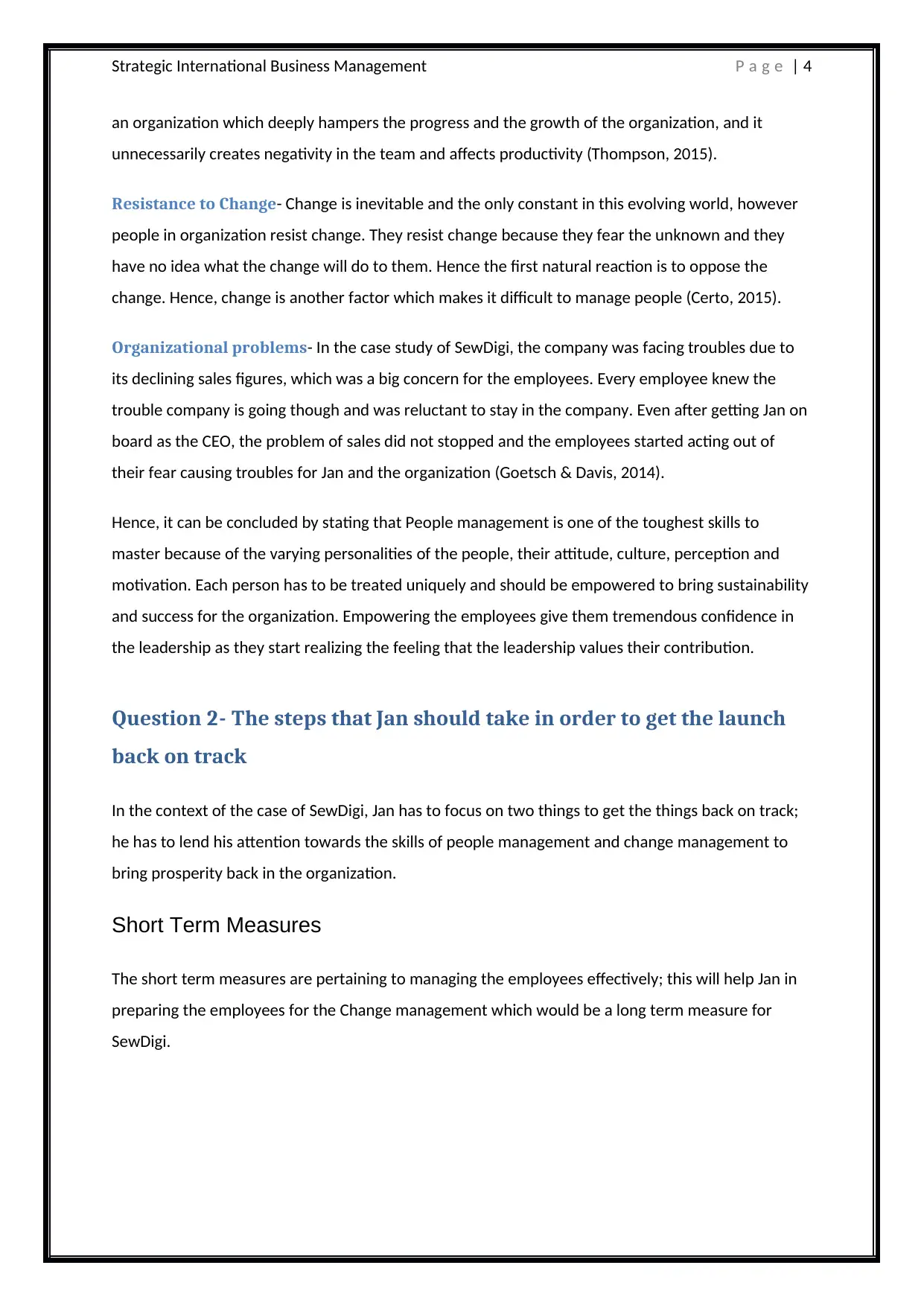
Strategic International Business Management P a g e | 4
an organization which deeply hampers the progress and the growth of the organization, and it
unnecessarily creates negativity in the team and affects productivity (Thompson, 2015).
Resistance to Change- Change is inevitable and the only constant in this evolving world, however
people in organization resist change. They resist change because they fear the unknown and they
have no idea what the change will do to them. Hence the first natural reaction is to oppose the
change. Hence, change is another factor which makes it difficult to manage people (Certo, 2015).
Organizational problems- In the case study of SewDigi, the company was facing troubles due to
its declining sales figures, which was a big concern for the employees. Every employee knew the
trouble company is going though and was reluctant to stay in the company. Even after getting Jan on
board as the CEO, the problem of sales did not stopped and the employees started acting out of
their fear causing troubles for Jan and the organization (Goetsch & Davis, 2014).
Hence, it can be concluded by stating that People management is one of the toughest skills to
master because of the varying personalities of the people, their attitude, culture, perception and
motivation. Each person has to be treated uniquely and should be empowered to bring sustainability
and success for the organization. Empowering the employees give them tremendous confidence in
the leadership as they start realizing the feeling that the leadership values their contribution.
Question 2- The steps that Jan should take in order to get the launch
back on track
In the context of the case of SewDigi, Jan has to focus on two things to get the things back on track;
he has to lend his attention towards the skills of people management and change management to
bring prosperity back in the organization.
Short Term Measures
The short term measures are pertaining to managing the employees effectively; this will help Jan in
preparing the employees for the Change management which would be a long term measure for
SewDigi.
an organization which deeply hampers the progress and the growth of the organization, and it
unnecessarily creates negativity in the team and affects productivity (Thompson, 2015).
Resistance to Change- Change is inevitable and the only constant in this evolving world, however
people in organization resist change. They resist change because they fear the unknown and they
have no idea what the change will do to them. Hence the first natural reaction is to oppose the
change. Hence, change is another factor which makes it difficult to manage people (Certo, 2015).
Organizational problems- In the case study of SewDigi, the company was facing troubles due to
its declining sales figures, which was a big concern for the employees. Every employee knew the
trouble company is going though and was reluctant to stay in the company. Even after getting Jan on
board as the CEO, the problem of sales did not stopped and the employees started acting out of
their fear causing troubles for Jan and the organization (Goetsch & Davis, 2014).
Hence, it can be concluded by stating that People management is one of the toughest skills to
master because of the varying personalities of the people, their attitude, culture, perception and
motivation. Each person has to be treated uniquely and should be empowered to bring sustainability
and success for the organization. Empowering the employees give them tremendous confidence in
the leadership as they start realizing the feeling that the leadership values their contribution.
Question 2- The steps that Jan should take in order to get the launch
back on track
In the context of the case of SewDigi, Jan has to focus on two things to get the things back on track;
he has to lend his attention towards the skills of people management and change management to
bring prosperity back in the organization.
Short Term Measures
The short term measures are pertaining to managing the employees effectively; this will help Jan in
preparing the employees for the Change management which would be a long term measure for
SewDigi.
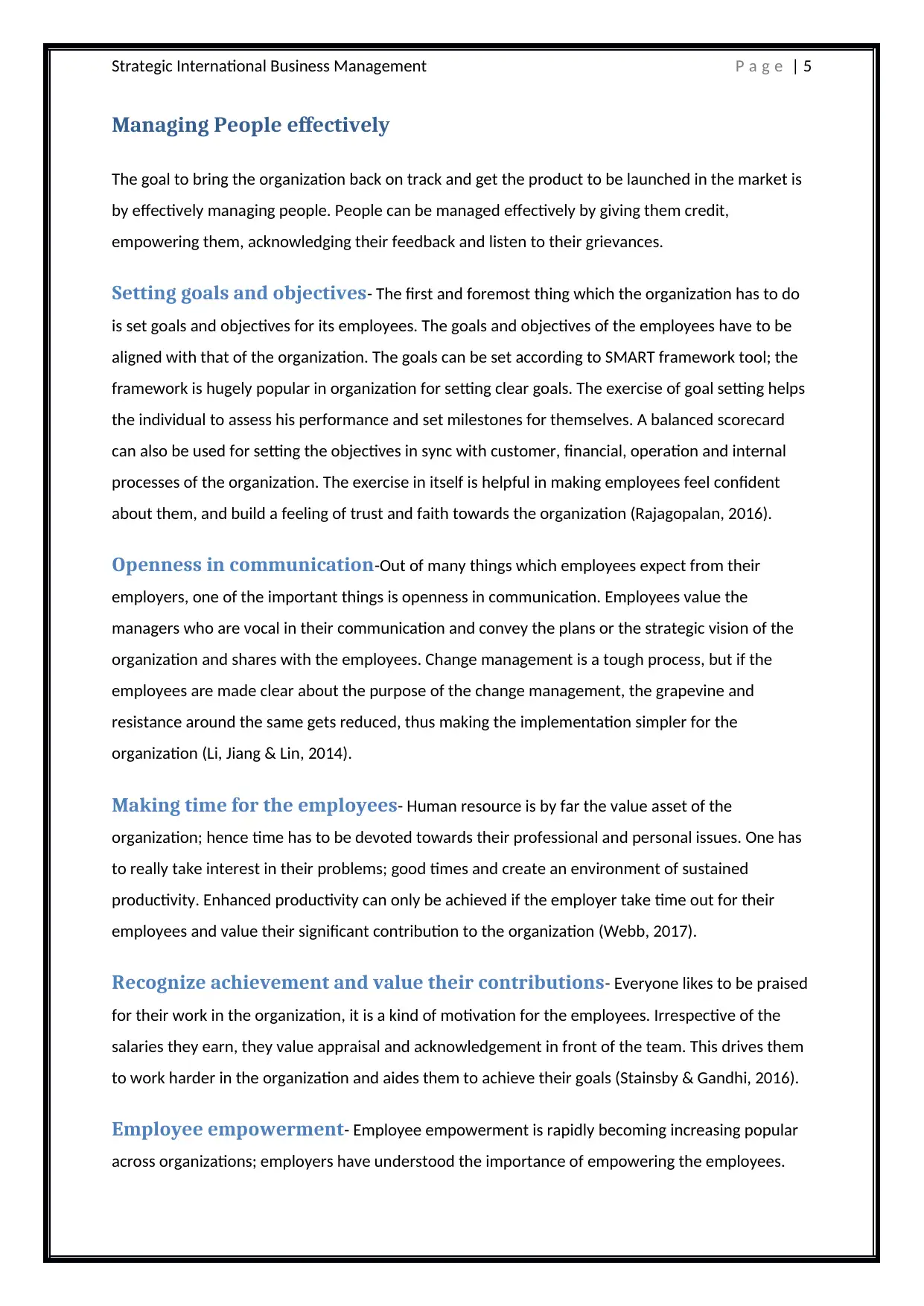
Strategic International Business Management P a g e | 5
Managing People effectively
The goal to bring the organization back on track and get the product to be launched in the market is
by effectively managing people. People can be managed effectively by giving them credit,
empowering them, acknowledging their feedback and listen to their grievances.
Setting goals and objectives- The first and foremost thing which the organization has to do
is set goals and objectives for its employees. The goals and objectives of the employees have to be
aligned with that of the organization. The goals can be set according to SMART framework tool; the
framework is hugely popular in organization for setting clear goals. The exercise of goal setting helps
the individual to assess his performance and set milestones for themselves. A balanced scorecard
can also be used for setting the objectives in sync with customer, financial, operation and internal
processes of the organization. The exercise in itself is helpful in making employees feel confident
about them, and build a feeling of trust and faith towards the organization (Rajagopalan, 2016).
Openness in communication-Out of many things which employees expect from their
employers, one of the important things is openness in communication. Employees value the
managers who are vocal in their communication and convey the plans or the strategic vision of the
organization and shares with the employees. Change management is a tough process, but if the
employees are made clear about the purpose of the change management, the grapevine and
resistance around the same gets reduced, thus making the implementation simpler for the
organization (Li, Jiang & Lin, 2014).
Making time for the employees- Human resource is by far the value asset of the
organization; hence time has to be devoted towards their professional and personal issues. One has
to really take interest in their problems; good times and create an environment of sustained
productivity. Enhanced productivity can only be achieved if the employer take time out for their
employees and value their significant contribution to the organization (Webb, 2017).
Recognize achievement and value their contributions- Everyone likes to be praised
for their work in the organization, it is a kind of motivation for the employees. Irrespective of the
salaries they earn, they value appraisal and acknowledgement in front of the team. This drives them
to work harder in the organization and aides them to achieve their goals (Stainsby & Gandhi, 2016).
Employee empowerment- Employee empowerment is rapidly becoming increasing popular
across organizations; employers have understood the importance of empowering the employees.
Managing People effectively
The goal to bring the organization back on track and get the product to be launched in the market is
by effectively managing people. People can be managed effectively by giving them credit,
empowering them, acknowledging their feedback and listen to their grievances.
Setting goals and objectives- The first and foremost thing which the organization has to do
is set goals and objectives for its employees. The goals and objectives of the employees have to be
aligned with that of the organization. The goals can be set according to SMART framework tool; the
framework is hugely popular in organization for setting clear goals. The exercise of goal setting helps
the individual to assess his performance and set milestones for themselves. A balanced scorecard
can also be used for setting the objectives in sync with customer, financial, operation and internal
processes of the organization. The exercise in itself is helpful in making employees feel confident
about them, and build a feeling of trust and faith towards the organization (Rajagopalan, 2016).
Openness in communication-Out of many things which employees expect from their
employers, one of the important things is openness in communication. Employees value the
managers who are vocal in their communication and convey the plans or the strategic vision of the
organization and shares with the employees. Change management is a tough process, but if the
employees are made clear about the purpose of the change management, the grapevine and
resistance around the same gets reduced, thus making the implementation simpler for the
organization (Li, Jiang & Lin, 2014).
Making time for the employees- Human resource is by far the value asset of the
organization; hence time has to be devoted towards their professional and personal issues. One has
to really take interest in their problems; good times and create an environment of sustained
productivity. Enhanced productivity can only be achieved if the employer take time out for their
employees and value their significant contribution to the organization (Webb, 2017).
Recognize achievement and value their contributions- Everyone likes to be praised
for their work in the organization, it is a kind of motivation for the employees. Irrespective of the
salaries they earn, they value appraisal and acknowledgement in front of the team. This drives them
to work harder in the organization and aides them to achieve their goals (Stainsby & Gandhi, 2016).
Employee empowerment- Employee empowerment is rapidly becoming increasing popular
across organizations; employers have understood the importance of empowering the employees.
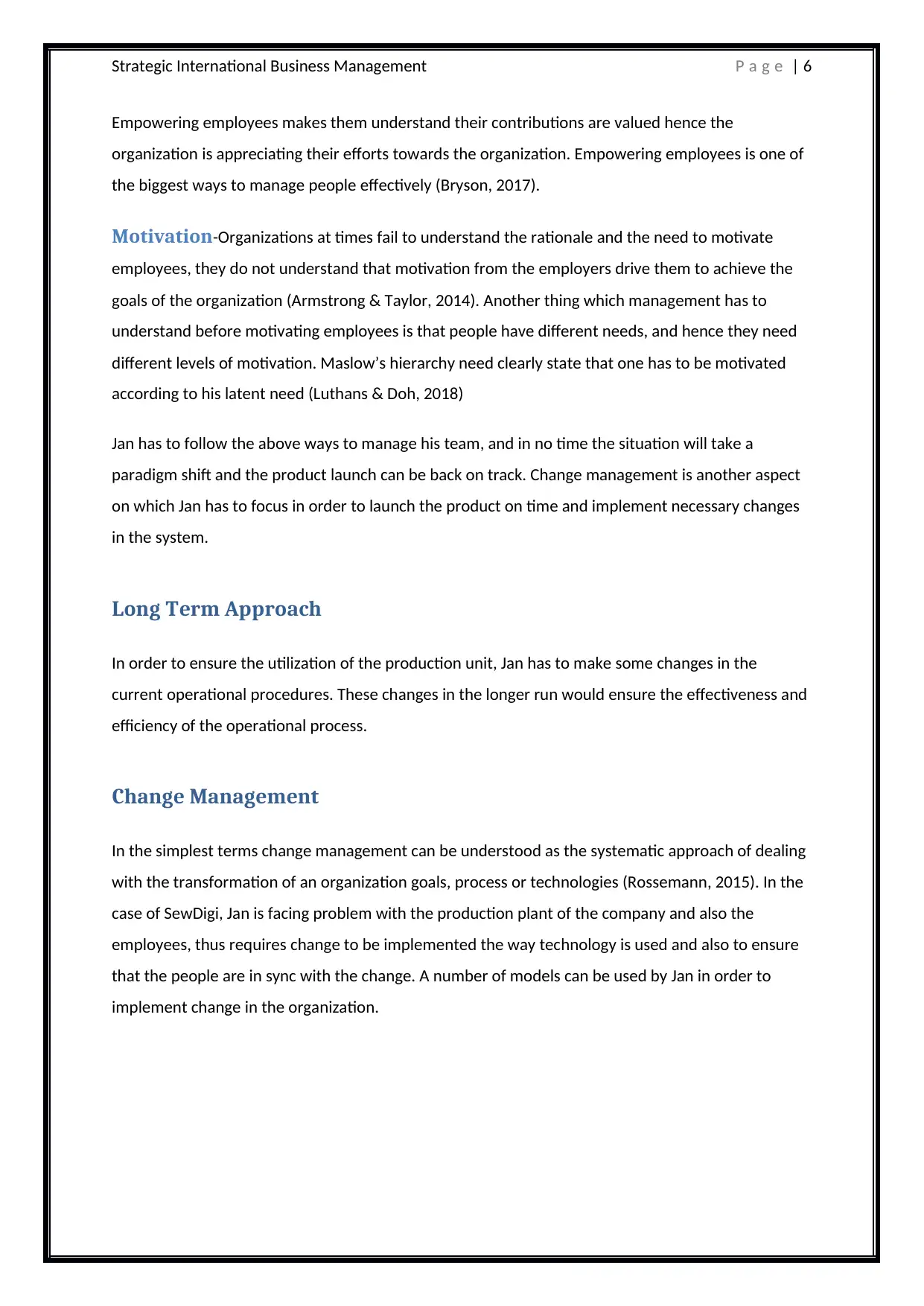
Strategic International Business Management P a g e | 6
Empowering employees makes them understand their contributions are valued hence the
organization is appreciating their efforts towards the organization. Empowering employees is one of
the biggest ways to manage people effectively (Bryson, 2017).
Motivation-Organizations at times fail to understand the rationale and the need to motivate
employees, they do not understand that motivation from the employers drive them to achieve the
goals of the organization (Armstrong & Taylor, 2014). Another thing which management has to
understand before motivating employees is that people have different needs, and hence they need
different levels of motivation. Maslow’s hierarchy need clearly state that one has to be motivated
according to his latent need (Luthans & Doh, 2018)
Jan has to follow the above ways to manage his team, and in no time the situation will take a
paradigm shift and the product launch can be back on track. Change management is another aspect
on which Jan has to focus in order to launch the product on time and implement necessary changes
in the system.
Long Term Approach
In order to ensure the utilization of the production unit, Jan has to make some changes in the
current operational procedures. These changes in the longer run would ensure the effectiveness and
efficiency of the operational process.
Change Management
In the simplest terms change management can be understood as the systematic approach of dealing
with the transformation of an organization goals, process or technologies (Rossemann, 2015). In the
case of SewDigi, Jan is facing problem with the production plant of the company and also the
employees, thus requires change to be implemented the way technology is used and also to ensure
that the people are in sync with the change. A number of models can be used by Jan in order to
implement change in the organization.
Empowering employees makes them understand their contributions are valued hence the
organization is appreciating their efforts towards the organization. Empowering employees is one of
the biggest ways to manage people effectively (Bryson, 2017).
Motivation-Organizations at times fail to understand the rationale and the need to motivate
employees, they do not understand that motivation from the employers drive them to achieve the
goals of the organization (Armstrong & Taylor, 2014). Another thing which management has to
understand before motivating employees is that people have different needs, and hence they need
different levels of motivation. Maslow’s hierarchy need clearly state that one has to be motivated
according to his latent need (Luthans & Doh, 2018)
Jan has to follow the above ways to manage his team, and in no time the situation will take a
paradigm shift and the product launch can be back on track. Change management is another aspect
on which Jan has to focus in order to launch the product on time and implement necessary changes
in the system.
Long Term Approach
In order to ensure the utilization of the production unit, Jan has to make some changes in the
current operational procedures. These changes in the longer run would ensure the effectiveness and
efficiency of the operational process.
Change Management
In the simplest terms change management can be understood as the systematic approach of dealing
with the transformation of an organization goals, process or technologies (Rossemann, 2015). In the
case of SewDigi, Jan is facing problem with the production plant of the company and also the
employees, thus requires change to be implemented the way technology is used and also to ensure
that the people are in sync with the change. A number of models can be used by Jan in order to
implement change in the organization.
Paraphrase This Document
Need a fresh take? Get an instant paraphrase of this document with our AI Paraphraser
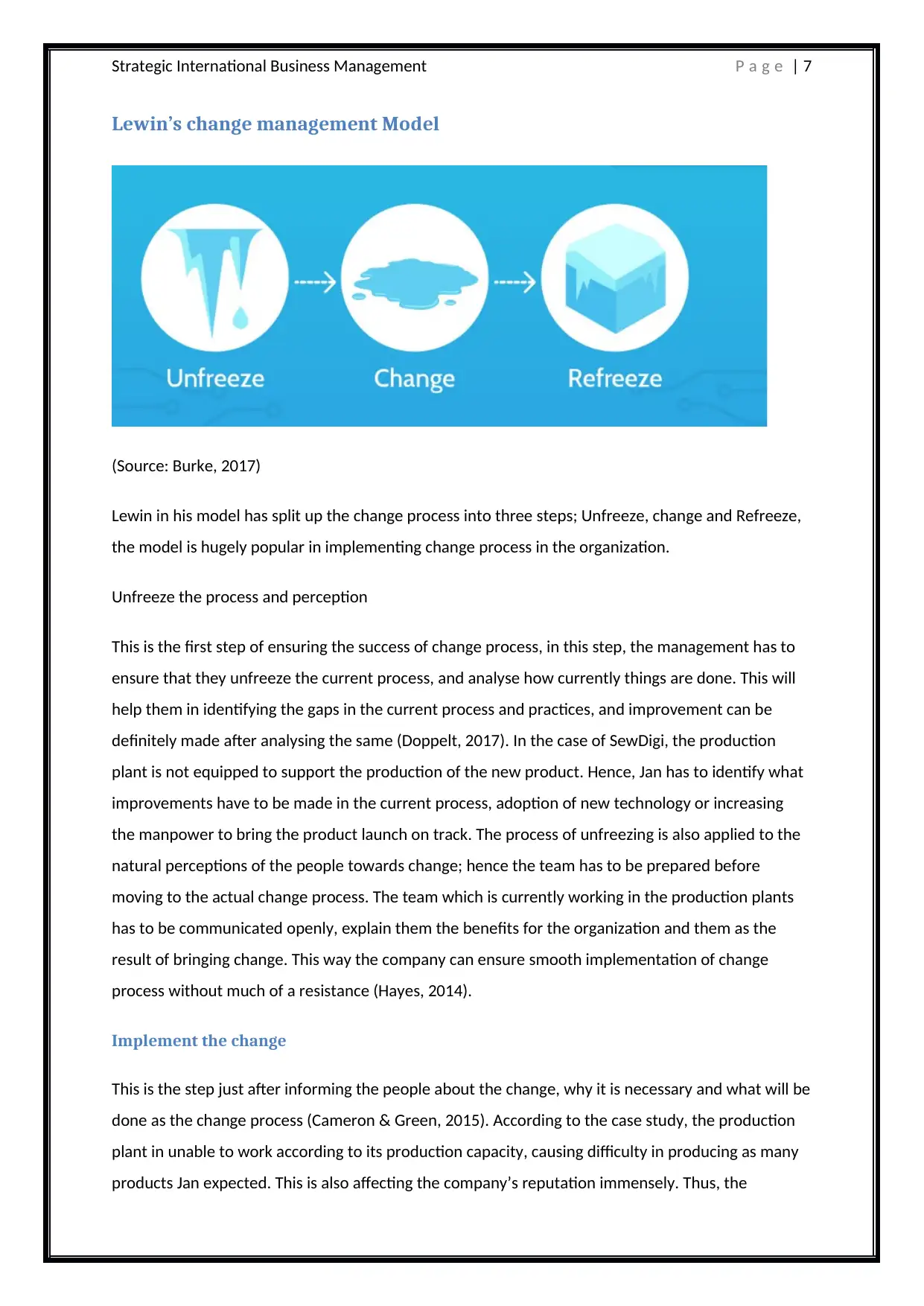
Strategic International Business Management P a g e | 7
Lewin’s change management Model
(Source: Burke, 2017)
Lewin in his model has split up the change process into three steps; Unfreeze, change and Refreeze,
the model is hugely popular in implementing change process in the organization.
Unfreeze the process and perception
This is the first step of ensuring the success of change process, in this step, the management has to
ensure that they unfreeze the current process, and analyse how currently things are done. This will
help them in identifying the gaps in the current process and practices, and improvement can be
definitely made after analysing the same (Doppelt, 2017). In the case of SewDigi, the production
plant is not equipped to support the production of the new product. Hence, Jan has to identify what
improvements have to be made in the current process, adoption of new technology or increasing
the manpower to bring the product launch on track. The process of unfreezing is also applied to the
natural perceptions of the people towards change; hence the team has to be prepared before
moving to the actual change process. The team which is currently working in the production plants
has to be communicated openly, explain them the benefits for the organization and them as the
result of bringing change. This way the company can ensure smooth implementation of change
process without much of a resistance (Hayes, 2014).
Implement the change
This is the step just after informing the people about the change, why it is necessary and what will be
done as the change process (Cameron & Green, 2015). According to the case study, the production
plant in unable to work according to its production capacity, causing difficulty in producing as many
products Jan expected. This is also affecting the company’s reputation immensely. Thus, the
Lewin’s change management Model
(Source: Burke, 2017)
Lewin in his model has split up the change process into three steps; Unfreeze, change and Refreeze,
the model is hugely popular in implementing change process in the organization.
Unfreeze the process and perception
This is the first step of ensuring the success of change process, in this step, the management has to
ensure that they unfreeze the current process, and analyse how currently things are done. This will
help them in identifying the gaps in the current process and practices, and improvement can be
definitely made after analysing the same (Doppelt, 2017). In the case of SewDigi, the production
plant is not equipped to support the production of the new product. Hence, Jan has to identify what
improvements have to be made in the current process, adoption of new technology or increasing
the manpower to bring the product launch on track. The process of unfreezing is also applied to the
natural perceptions of the people towards change; hence the team has to be prepared before
moving to the actual change process. The team which is currently working in the production plants
has to be communicated openly, explain them the benefits for the organization and them as the
result of bringing change. This way the company can ensure smooth implementation of change
process without much of a resistance (Hayes, 2014).
Implement the change
This is the step just after informing the people about the change, why it is necessary and what will be
done as the change process (Cameron & Green, 2015). According to the case study, the production
plant in unable to work according to its production capacity, causing difficulty in producing as many
products Jan expected. This is also affecting the company’s reputation immensely. Thus, the
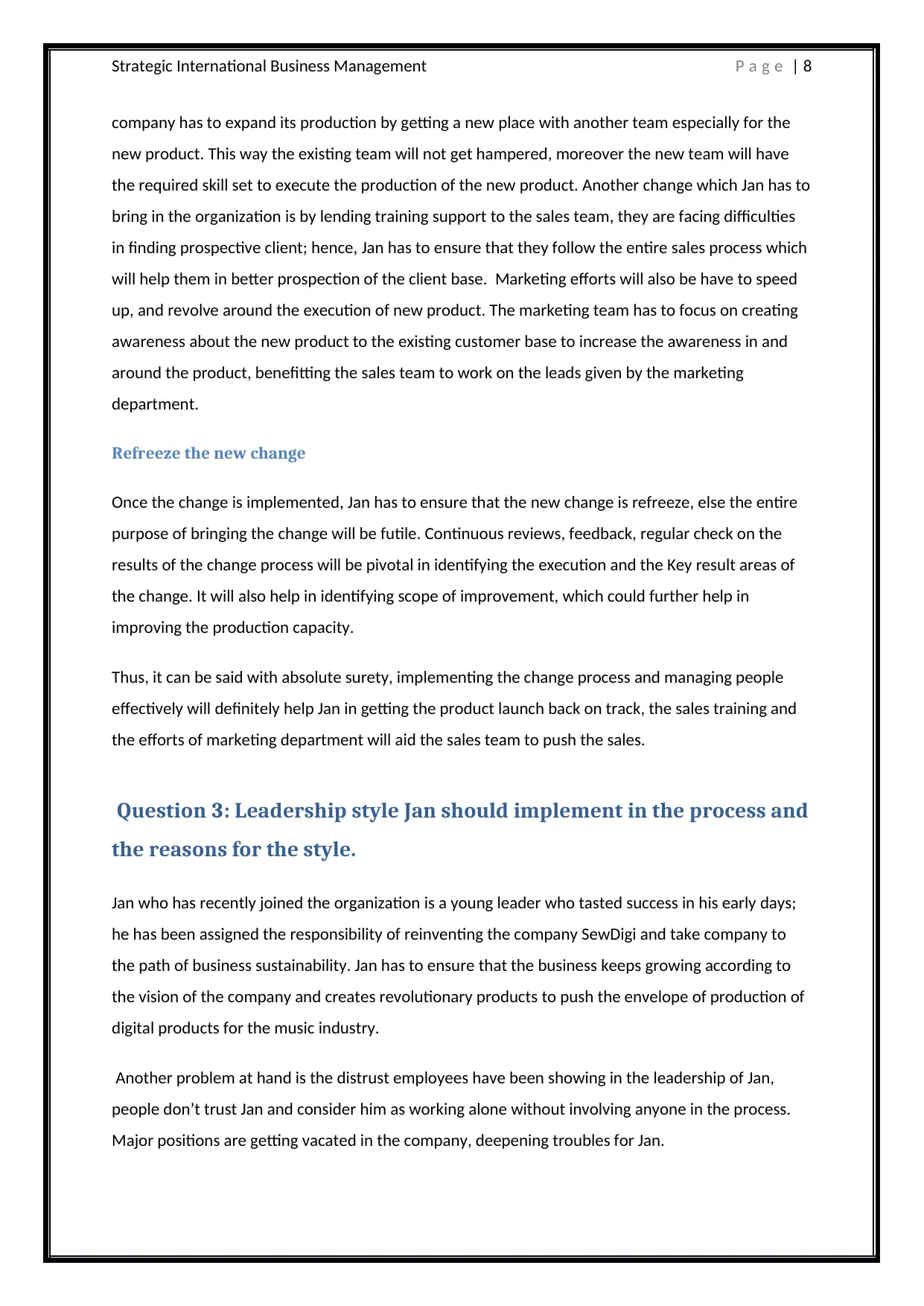
Strategic International Business Management P a g e | 8
company has to expand its production by getting a new place with another team especially for the
new product. This way the existing team will not get hampered, moreover the new team will have
the required skill set to execute the production of the new product. Another change which Jan has to
bring in the organization is by lending training support to the sales team, they are facing difficulties
in finding prospective client; hence, Jan has to ensure that they follow the entire sales process which
will help them in better prospection of the client base. Marketing efforts will also be have to speed
up, and revolve around the execution of new product. The marketing team has to focus on creating
awareness about the new product to the existing customer base to increase the awareness in and
around the product, benefitting the sales team to work on the leads given by the marketing
department.
Refreeze the new change
Once the change is implemented, Jan has to ensure that the new change is refreeze, else the entire
purpose of bringing the change will be futile. Continuous reviews, feedback, regular check on the
results of the change process will be pivotal in identifying the execution and the Key result areas of
the change. It will also help in identifying scope of improvement, which could further help in
improving the production capacity.
Thus, it can be said with absolute surety, implementing the change process and managing people
effectively will definitely help Jan in getting the product launch back on track, the sales training and
the efforts of marketing department will aid the sales team to push the sales.
Question 3: Leadership style Jan should implement in the process and
the reasons for the style.
Jan who has recently joined the organization is a young leader who tasted success in his early days;
he has been assigned the responsibility of reinventing the company SewDigi and take company to
the path of business sustainability. Jan has to ensure that the business keeps growing according to
the vision of the company and creates revolutionary products to push the envelope of production of
digital products for the music industry.
Another problem at hand is the distrust employees have been showing in the leadership of Jan,
people don’t trust Jan and consider him as working alone without involving anyone in the process.
Major positions are getting vacated in the company, deepening troubles for Jan.
company has to expand its production by getting a new place with another team especially for the
new product. This way the existing team will not get hampered, moreover the new team will have
the required skill set to execute the production of the new product. Another change which Jan has to
bring in the organization is by lending training support to the sales team, they are facing difficulties
in finding prospective client; hence, Jan has to ensure that they follow the entire sales process which
will help them in better prospection of the client base. Marketing efforts will also be have to speed
up, and revolve around the execution of new product. The marketing team has to focus on creating
awareness about the new product to the existing customer base to increase the awareness in and
around the product, benefitting the sales team to work on the leads given by the marketing
department.
Refreeze the new change
Once the change is implemented, Jan has to ensure that the new change is refreeze, else the entire
purpose of bringing the change will be futile. Continuous reviews, feedback, regular check on the
results of the change process will be pivotal in identifying the execution and the Key result areas of
the change. It will also help in identifying scope of improvement, which could further help in
improving the production capacity.
Thus, it can be said with absolute surety, implementing the change process and managing people
effectively will definitely help Jan in getting the product launch back on track, the sales training and
the efforts of marketing department will aid the sales team to push the sales.
Question 3: Leadership style Jan should implement in the process and
the reasons for the style.
Jan who has recently joined the organization is a young leader who tasted success in his early days;
he has been assigned the responsibility of reinventing the company SewDigi and take company to
the path of business sustainability. Jan has to ensure that the business keeps growing according to
the vision of the company and creates revolutionary products to push the envelope of production of
digital products for the music industry.
Another problem at hand is the distrust employees have been showing in the leadership of Jan,
people don’t trust Jan and consider him as working alone without involving anyone in the process.
Major positions are getting vacated in the company, deepening troubles for Jan.
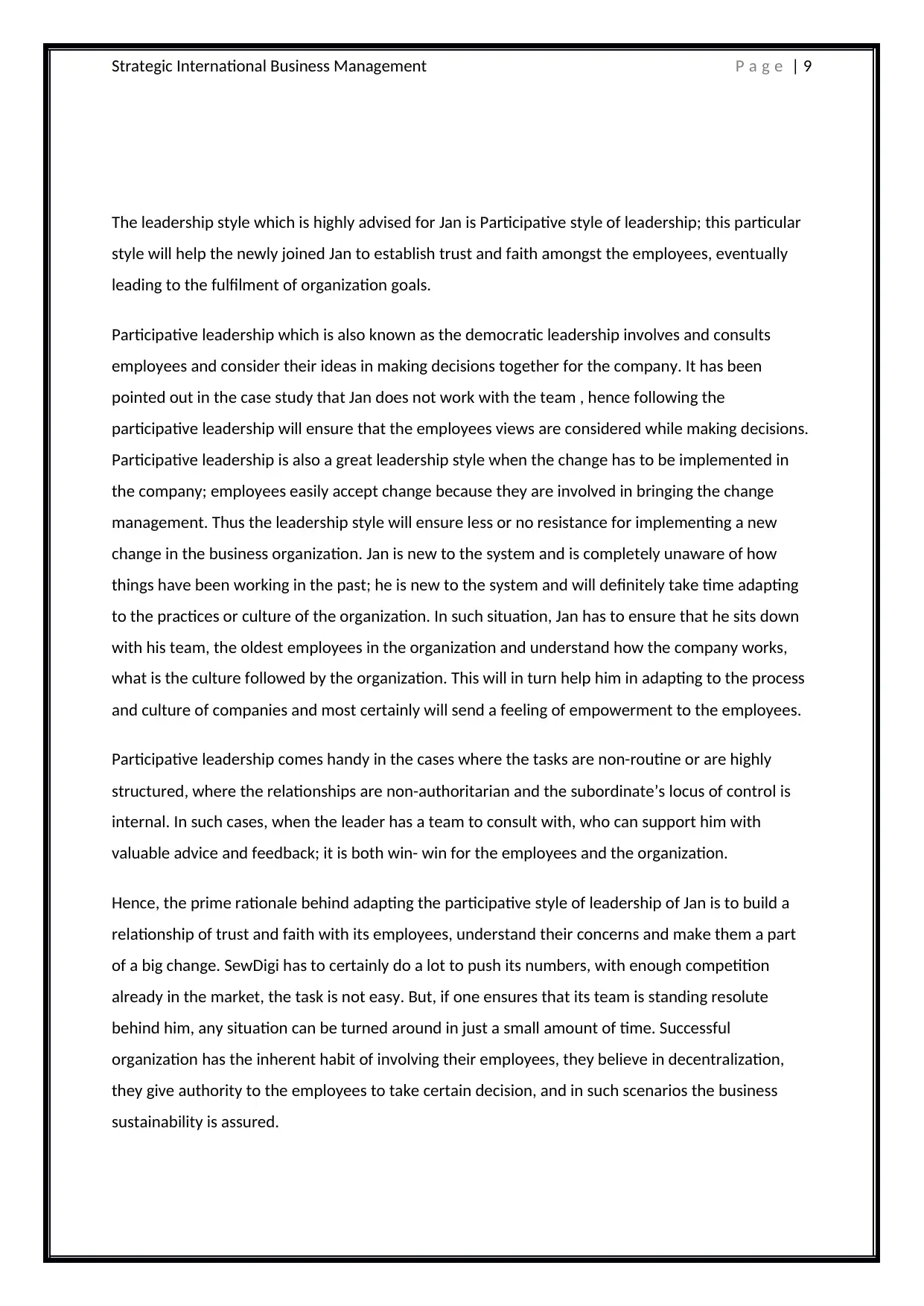
Strategic International Business Management P a g e | 9
The leadership style which is highly advised for Jan is Participative style of leadership; this particular
style will help the newly joined Jan to establish trust and faith amongst the employees, eventually
leading to the fulfilment of organization goals.
Participative leadership which is also known as the democratic leadership involves and consults
employees and consider their ideas in making decisions together for the company. It has been
pointed out in the case study that Jan does not work with the team , hence following the
participative leadership will ensure that the employees views are considered while making decisions.
Participative leadership is also a great leadership style when the change has to be implemented in
the company; employees easily accept change because they are involved in bringing the change
management. Thus the leadership style will ensure less or no resistance for implementing a new
change in the business organization. Jan is new to the system and is completely unaware of how
things have been working in the past; he is new to the system and will definitely take time adapting
to the practices or culture of the organization. In such situation, Jan has to ensure that he sits down
with his team, the oldest employees in the organization and understand how the company works,
what is the culture followed by the organization. This will in turn help him in adapting to the process
and culture of companies and most certainly will send a feeling of empowerment to the employees.
Participative leadership comes handy in the cases where the tasks are non-routine or are highly
structured, where the relationships are non-authoritarian and the subordinate’s locus of control is
internal. In such cases, when the leader has a team to consult with, who can support him with
valuable advice and feedback; it is both win- win for the employees and the organization.
Hence, the prime rationale behind adapting the participative style of leadership of Jan is to build a
relationship of trust and faith with its employees, understand their concerns and make them a part
of a big change. SewDigi has to certainly do a lot to push its numbers, with enough competition
already in the market, the task is not easy. But, if one ensures that its team is standing resolute
behind him, any situation can be turned around in just a small amount of time. Successful
organization has the inherent habit of involving their employees, they believe in decentralization,
they give authority to the employees to take certain decision, and in such scenarios the business
sustainability is assured.
The leadership style which is highly advised for Jan is Participative style of leadership; this particular
style will help the newly joined Jan to establish trust and faith amongst the employees, eventually
leading to the fulfilment of organization goals.
Participative leadership which is also known as the democratic leadership involves and consults
employees and consider their ideas in making decisions together for the company. It has been
pointed out in the case study that Jan does not work with the team , hence following the
participative leadership will ensure that the employees views are considered while making decisions.
Participative leadership is also a great leadership style when the change has to be implemented in
the company; employees easily accept change because they are involved in bringing the change
management. Thus the leadership style will ensure less or no resistance for implementing a new
change in the business organization. Jan is new to the system and is completely unaware of how
things have been working in the past; he is new to the system and will definitely take time adapting
to the practices or culture of the organization. In such situation, Jan has to ensure that he sits down
with his team, the oldest employees in the organization and understand how the company works,
what is the culture followed by the organization. This will in turn help him in adapting to the process
and culture of companies and most certainly will send a feeling of empowerment to the employees.
Participative leadership comes handy in the cases where the tasks are non-routine or are highly
structured, where the relationships are non-authoritarian and the subordinate’s locus of control is
internal. In such cases, when the leader has a team to consult with, who can support him with
valuable advice and feedback; it is both win- win for the employees and the organization.
Hence, the prime rationale behind adapting the participative style of leadership of Jan is to build a
relationship of trust and faith with its employees, understand their concerns and make them a part
of a big change. SewDigi has to certainly do a lot to push its numbers, with enough competition
already in the market, the task is not easy. But, if one ensures that its team is standing resolute
behind him, any situation can be turned around in just a small amount of time. Successful
organization has the inherent habit of involving their employees, they believe in decentralization,
they give authority to the employees to take certain decision, and in such scenarios the business
sustainability is assured.
Secure Best Marks with AI Grader
Need help grading? Try our AI Grader for instant feedback on your assignments.
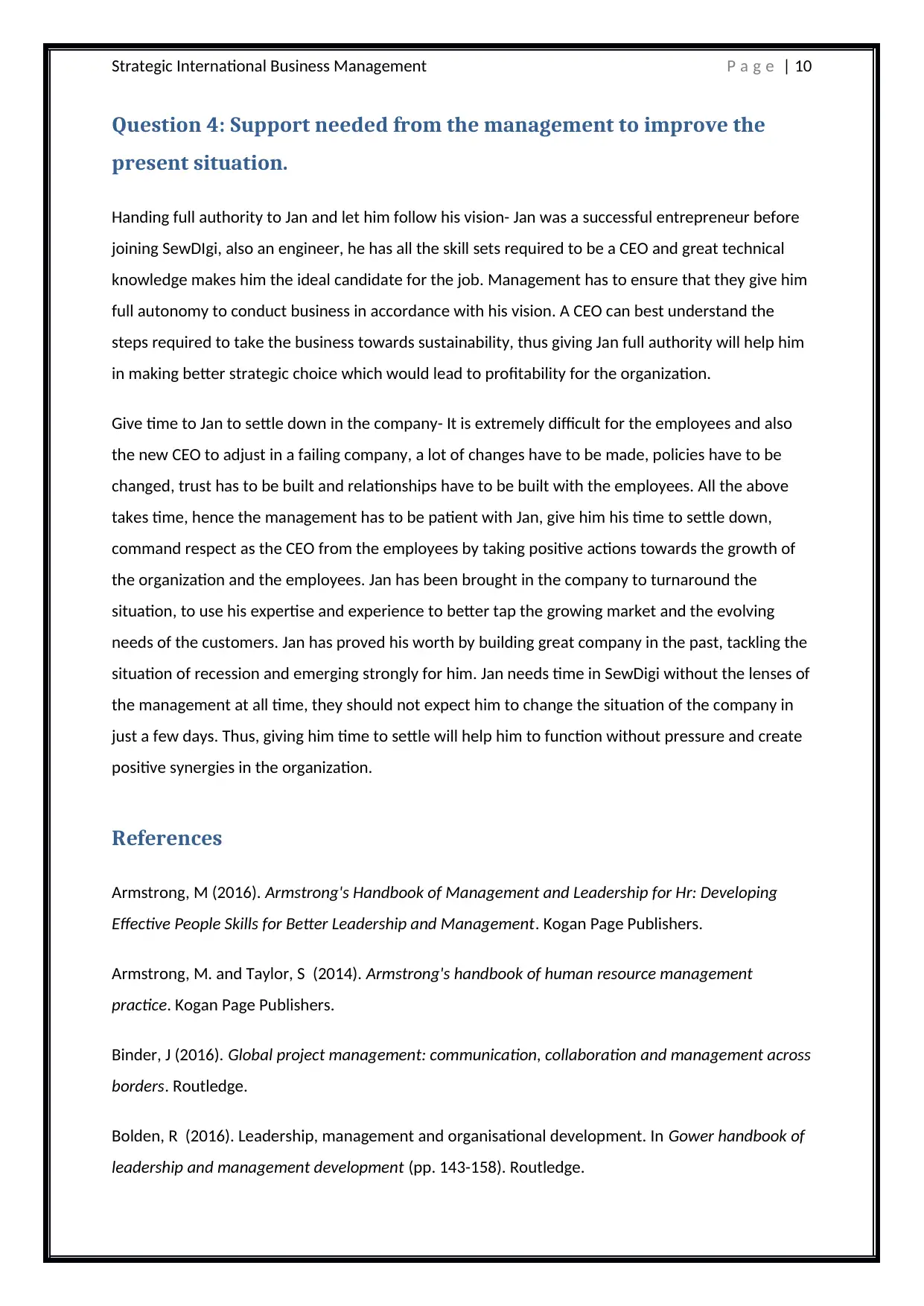
Strategic International Business Management P a g e | 10
Question 4: Support needed from the management to improve the
present situation.
Handing full authority to Jan and let him follow his vision- Jan was a successful entrepreneur before
joining SewDIgi, also an engineer, he has all the skill sets required to be a CEO and great technical
knowledge makes him the ideal candidate for the job. Management has to ensure that they give him
full autonomy to conduct business in accordance with his vision. A CEO can best understand the
steps required to take the business towards sustainability, thus giving Jan full authority will help him
in making better strategic choice which would lead to profitability for the organization.
Give time to Jan to settle down in the company- It is extremely difficult for the employees and also
the new CEO to adjust in a failing company, a lot of changes have to be made, policies have to be
changed, trust has to be built and relationships have to be built with the employees. All the above
takes time, hence the management has to be patient with Jan, give him his time to settle down,
command respect as the CEO from the employees by taking positive actions towards the growth of
the organization and the employees. Jan has been brought in the company to turnaround the
situation, to use his expertise and experience to better tap the growing market and the evolving
needs of the customers. Jan has proved his worth by building great company in the past, tackling the
situation of recession and emerging strongly for him. Jan needs time in SewDigi without the lenses of
the management at all time, they should not expect him to change the situation of the company in
just a few days. Thus, giving him time to settle will help him to function without pressure and create
positive synergies in the organization.
References
Armstrong, M (2016). Armstrong's Handbook of Management and Leadership for Hr: Developing
Effective People Skills for Better Leadership and Management. Kogan Page Publishers.
Armstrong, M. and Taylor, S (2014). Armstrong's handbook of human resource management
practice. Kogan Page Publishers.
Binder, J (2016). Global project management: communication, collaboration and management across
borders. Routledge.
Bolden, R (2016). Leadership, management and organisational development. In Gower handbook of
leadership and management development (pp. 143-158). Routledge.
Question 4: Support needed from the management to improve the
present situation.
Handing full authority to Jan and let him follow his vision- Jan was a successful entrepreneur before
joining SewDIgi, also an engineer, he has all the skill sets required to be a CEO and great technical
knowledge makes him the ideal candidate for the job. Management has to ensure that they give him
full autonomy to conduct business in accordance with his vision. A CEO can best understand the
steps required to take the business towards sustainability, thus giving Jan full authority will help him
in making better strategic choice which would lead to profitability for the organization.
Give time to Jan to settle down in the company- It is extremely difficult for the employees and also
the new CEO to adjust in a failing company, a lot of changes have to be made, policies have to be
changed, trust has to be built and relationships have to be built with the employees. All the above
takes time, hence the management has to be patient with Jan, give him his time to settle down,
command respect as the CEO from the employees by taking positive actions towards the growth of
the organization and the employees. Jan has been brought in the company to turnaround the
situation, to use his expertise and experience to better tap the growing market and the evolving
needs of the customers. Jan has proved his worth by building great company in the past, tackling the
situation of recession and emerging strongly for him. Jan needs time in SewDigi without the lenses of
the management at all time, they should not expect him to change the situation of the company in
just a few days. Thus, giving him time to settle will help him to function without pressure and create
positive synergies in the organization.
References
Armstrong, M (2016). Armstrong's Handbook of Management and Leadership for Hr: Developing
Effective People Skills for Better Leadership and Management. Kogan Page Publishers.
Armstrong, M. and Taylor, S (2014). Armstrong's handbook of human resource management
practice. Kogan Page Publishers.
Binder, J (2016). Global project management: communication, collaboration and management across
borders. Routledge.
Bolden, R (2016). Leadership, management and organisational development. In Gower handbook of
leadership and management development (pp. 143-158). Routledge.
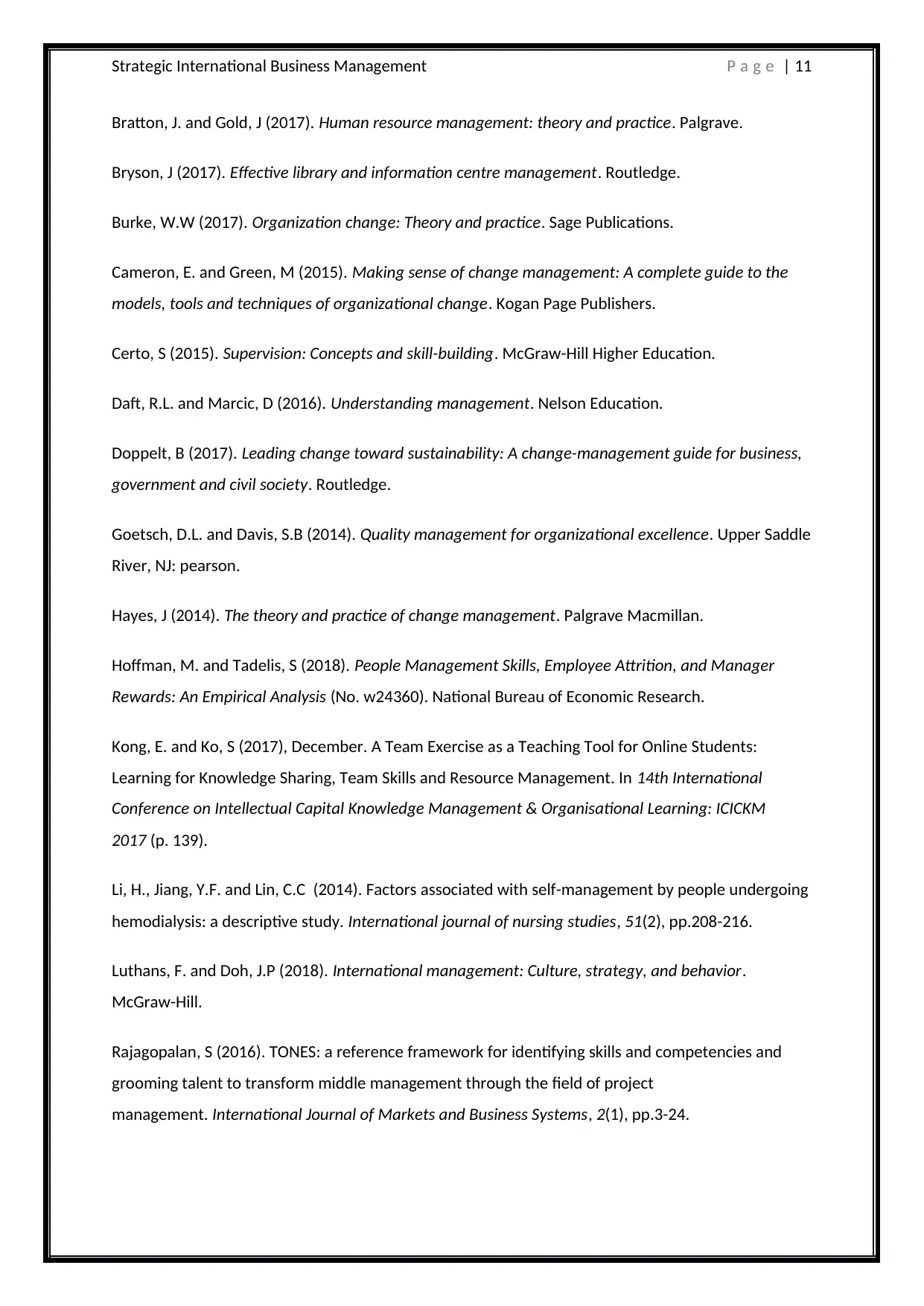
Strategic International Business Management P a g e | 11
Bratton, J. and Gold, J (2017). Human resource management: theory and practice. Palgrave.
Bryson, J (2017). Effective library and information centre management. Routledge.
Burke, W.W (2017). Organization change: Theory and practice. Sage Publications.
Cameron, E. and Green, M (2015). Making sense of change management: A complete guide to the
models, tools and techniques of organizational change. Kogan Page Publishers.
Certo, S (2015). Supervision: Concepts and skill-building. McGraw-Hill Higher Education.
Daft, R.L. and Marcic, D (2016). Understanding management. Nelson Education.
Doppelt, B (2017). Leading change toward sustainability: A change-management guide for business,
government and civil society. Routledge.
Goetsch, D.L. and Davis, S.B (2014). Quality management for organizational excellence. Upper Saddle
River, NJ: pearson.
Hayes, J (2014). The theory and practice of change management. Palgrave Macmillan.
Hoffman, M. and Tadelis, S (2018). People Management Skills, Employee Attrition, and Manager
Rewards: An Empirical Analysis (No. w24360). National Bureau of Economic Research.
Kong, E. and Ko, S (2017), December. A Team Exercise as a Teaching Tool for Online Students:
Learning for Knowledge Sharing, Team Skills and Resource Management. In 14th International
Conference on Intellectual Capital Knowledge Management & Organisational Learning: ICICKM
2017 (p. 139).
Li, H., Jiang, Y.F. and Lin, C.C (2014). Factors associated with self-management by people undergoing
hemodialysis: a descriptive study. International journal of nursing studies, 51(2), pp.208-216.
Luthans, F. and Doh, J.P (2018). International management: Culture, strategy, and behavior.
McGraw-Hill.
Rajagopalan, S (2016). TONES: a reference framework for identifying skills and competencies and
grooming talent to transform middle management through the field of project
management. International Journal of Markets and Business Systems, 2(1), pp.3-24.
Bratton, J. and Gold, J (2017). Human resource management: theory and practice. Palgrave.
Bryson, J (2017). Effective library and information centre management. Routledge.
Burke, W.W (2017). Organization change: Theory and practice. Sage Publications.
Cameron, E. and Green, M (2015). Making sense of change management: A complete guide to the
models, tools and techniques of organizational change. Kogan Page Publishers.
Certo, S (2015). Supervision: Concepts and skill-building. McGraw-Hill Higher Education.
Daft, R.L. and Marcic, D (2016). Understanding management. Nelson Education.
Doppelt, B (2017). Leading change toward sustainability: A change-management guide for business,
government and civil society. Routledge.
Goetsch, D.L. and Davis, S.B (2014). Quality management for organizational excellence. Upper Saddle
River, NJ: pearson.
Hayes, J (2014). The theory and practice of change management. Palgrave Macmillan.
Hoffman, M. and Tadelis, S (2018). People Management Skills, Employee Attrition, and Manager
Rewards: An Empirical Analysis (No. w24360). National Bureau of Economic Research.
Kong, E. and Ko, S (2017), December. A Team Exercise as a Teaching Tool for Online Students:
Learning for Knowledge Sharing, Team Skills and Resource Management. In 14th International
Conference on Intellectual Capital Knowledge Management & Organisational Learning: ICICKM
2017 (p. 139).
Li, H., Jiang, Y.F. and Lin, C.C (2014). Factors associated with self-management by people undergoing
hemodialysis: a descriptive study. International journal of nursing studies, 51(2), pp.208-216.
Luthans, F. and Doh, J.P (2018). International management: Culture, strategy, and behavior.
McGraw-Hill.
Rajagopalan, S (2016). TONES: a reference framework for identifying skills and competencies and
grooming talent to transform middle management through the field of project
management. International Journal of Markets and Business Systems, 2(1), pp.3-24.
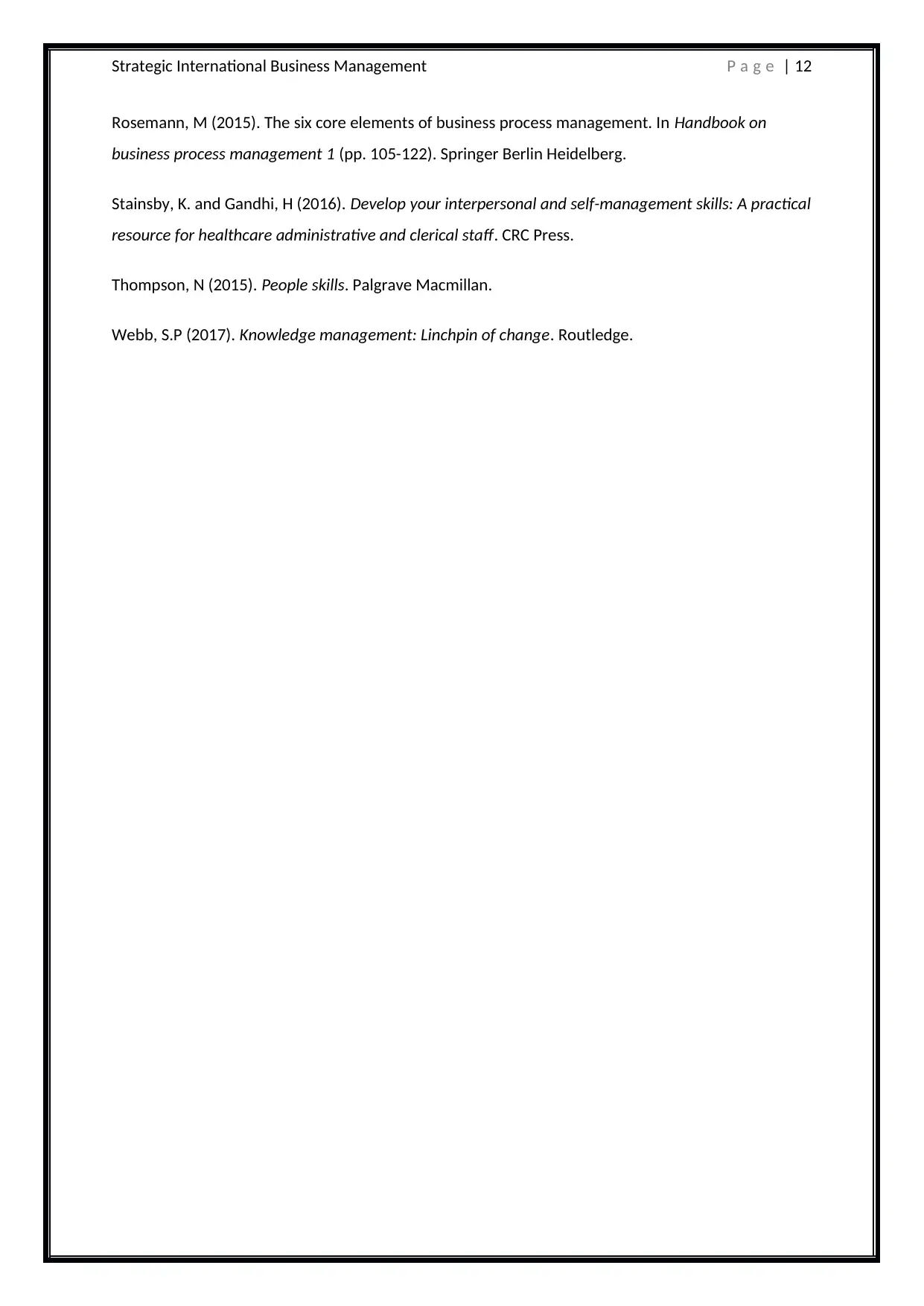
Strategic International Business Management P a g e | 12
Rosemann, M (2015). The six core elements of business process management. In Handbook on
business process management 1 (pp. 105-122). Springer Berlin Heidelberg.
Stainsby, K. and Gandhi, H (2016). Develop your interpersonal and self-management skills: A practical
resource for healthcare administrative and clerical staff. CRC Press.
Thompson, N (2015). People skills. Palgrave Macmillan.
Webb, S.P (2017). Knowledge management: Linchpin of change. Routledge.
Rosemann, M (2015). The six core elements of business process management. In Handbook on
business process management 1 (pp. 105-122). Springer Berlin Heidelberg.
Stainsby, K. and Gandhi, H (2016). Develop your interpersonal and self-management skills: A practical
resource for healthcare administrative and clerical staff. CRC Press.
Thompson, N (2015). People skills. Palgrave Macmillan.
Webb, S.P (2017). Knowledge management: Linchpin of change. Routledge.
1 out of 13
Related Documents
Your All-in-One AI-Powered Toolkit for Academic Success.
+13062052269
info@desklib.com
Available 24*7 on WhatsApp / Email
![[object Object]](/_next/static/media/star-bottom.7253800d.svg)
Unlock your academic potential
© 2024 | Zucol Services PVT LTD | All rights reserved.




